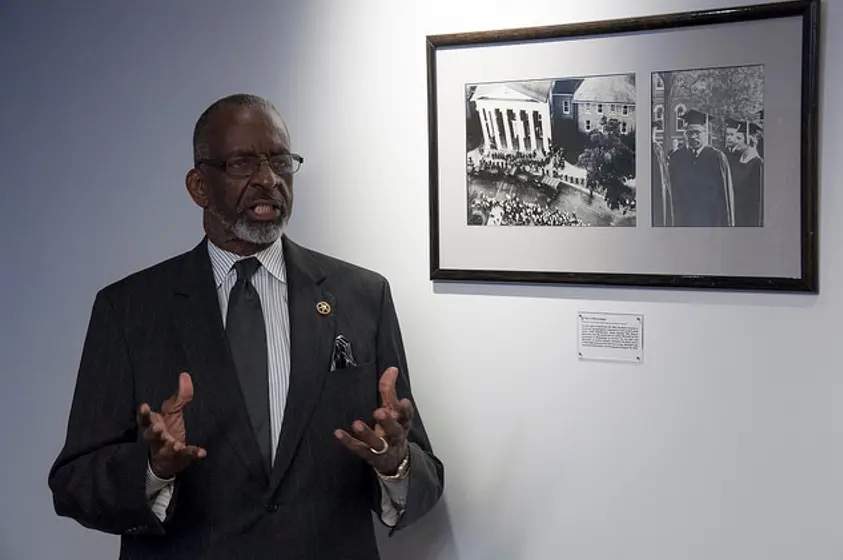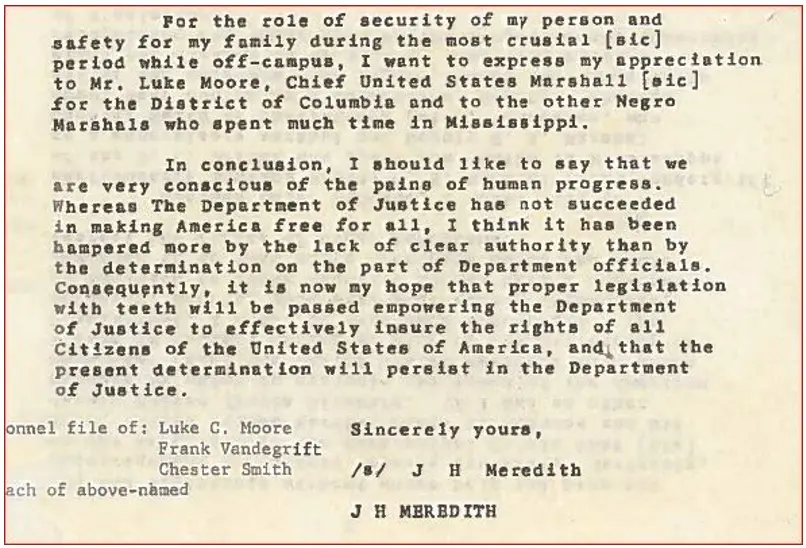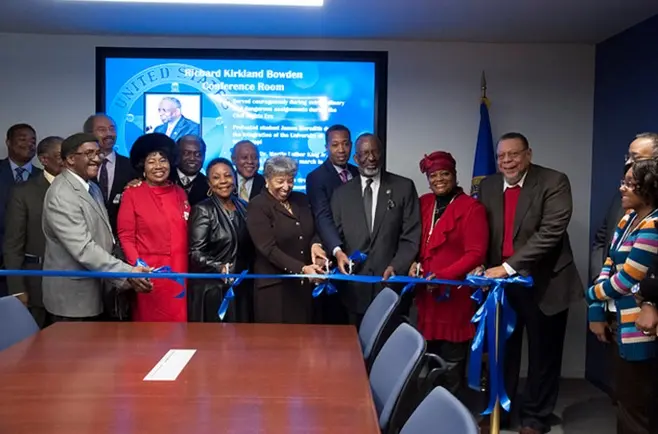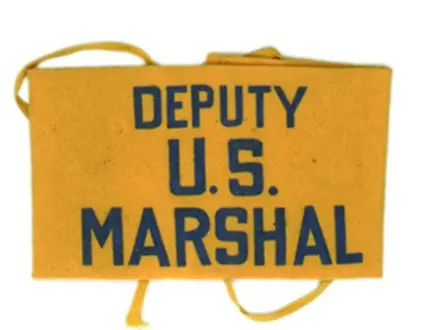
Looking Back at Assistant Chief U.S. Marshal Richard Kirkland Bowden and His Unique Place in American History
By David S. Turk, U.S. Marshals Service Historian
This is a place holder for subtitle.
For immediate release

Supervisory Deputy U.S. Marshal (retired) Richard “Kirk” Bowden during the December 2016 dedication ceremony at USMS headquarters.
It’s hard to believe that five years have passed, since January 20, 2018, when the United States Marshals Service (USMS) lost a legend of the Civil Rights Era. Richard Kirkland "Kirk" Bowden shined as an example of a man brave enough to travel the unlit, shadowy roads of risk. As a young African American Deputy United States Marshal (DUSM), he saw to the off-campus safety of James Meredith, the transfer student who broke the color barrier at the University of Mississippi, from late 1962 through August 1963. Kirk Bowden took risks few understood—or even knew. In fact, his time in Mississippi was part of a secret detail kept from most personnel within the Department of Justice. Even decades after the event, most other DUSMs on the Meredith protective detail at Ole Miss were unaware of his presence or mission. The weekend details with Meredith provided a portal into history from an obscured vantage point. Several important assignments and duties would mark his long illustrious career in law enforcement.
Mr. Bowden was born on December 24, 1935, in Memphis, Tennessee. His parents enrolled him in a pre-school program for public school, and he took to educational endeavors. While attending Douglass High School, he took on the job of editing its yearbook. After a short time at LeMoyne College studying dentistry, Mr. Bowden enlisted in the U.S. Air Force. It was during his enlistment that he initiated a career in law enforcement. From 1954 to 1958, he served in the Air Force’s Criminal Intelligence Division. He transitioned back to civilian life, settling in Washington, D.C., and secured a position with the Metropolitan Police Department’s Narcotic Division. After joining the U.S. Marshals, he took advantage of the educational training courses offered through these positions to enhance his assignment opportunities.
On October 12, 1962, in the aftermath of the riots at the University of Mississippi, Deputy Attorney General Nicholas Katzenbach requested two African American “deputy United States marshals to be sent from D.C. to Memphis to serve as bodyguards over [James] Meredith for the weekend, in Jackson [Mississippi].” This fact was uncovered from meticulous notes, long-buried in the files of John W. Cameron, one of the officials in the Executive Office for U.S. Marshals. Cameron called U.S. Marshal (USM) Luke C. Moore and made the necessary arrangements for the DUSMs to provide off-campus protective details. There was to be a rotation of duty, so ultimately at least five deputies were utilized. The DUSMs were instructed by both Cameron and Moore not to reveal their location to anyone while in Mississippi. “There is to be no publicity,” they were told.
There was good reason for the silence. Mr. Bowden and four other African American DUSMs – Howard E. Riley, Joseph N. Robinson, Charles Jackson and Jim Palmer – took tremendous risks in their day-to-day tasks in parts of the South rife with racial violence. Segregationists targeted James Meredith as a singular point of focus. He could be easily spotted in the segregated community if protected by white DUSMs. Even visits to friends could prove dangerous. Mr. Bowden often spoke of encounters with African American citizens, some of whom were fearful of reprisal.
The protectee and his detail sometimes stayed with families in small towns; surreptitiously visited a favorite barber; and frequently changed their routes as needed to reach their destination, usually in Memphis, Tennessee, or Jackson, Mississippi.
“While they were nervous about feeding us, we always ate well,” Bowden said with a smile, noting the portions were generous. There were few official references to the Mississippi details before James Meredith’s graduation in August 1963, but Meredith thanked the African American DUSMs on his detail without naming them.

Portion of 1963 copied letter from James Meredith, thanking the deputies and the Department of Justice.
On August 28, 1963, Mr. Bowden was back in Washington, D.C. when USM Moore selected him to keep close watch on Dr. Martin Luther King, Jr during the Washington March for Jobs and Freedom. Fears of violence during the event prompted several law enforcement organizations to organize without being a noticeable presence. A small number of personnel were deployed, but primary to monitor the march route. Kirk Bowden weaved through the large crowds in the march, and remained in close proximity to Dr. King when he gave the famous “I Have a Dream” speech at the Lincoln Memorial after midday.
With these vital experiences, Kirk Bowden found himself in the center of many other events during the Civil Rights Era and afterwards. Even after USM Moore’s departure after the 1968 elections, he continued to draw key assignments of national importance. By the 1970s, he was promoted to Supervisory Deputy U.S. Marshal (SDUSM) for the District of Columbia office. During the Watergate trials of 1975, Mr. Bowden assumed responsibility for the sequestered jury. When special protection was needed for visiting foreign judicial officials, he made the arrangements and ensured flawless execution of the details. In the role of mentor, he trained and inspired a large number of deputies who rose to leadership positions. Former USMS Director Stacia A. Hylton credited Kirk Bowden for his tutelage and professional guidance of her as a new Deputy United States Marshal. This friendship continued after his retirement from the USMS, as Assistant Chief Deputy U.S. Marshal in 1987.
Mr. Bowden never really left the ranks of the USMS. He remained a district security officer and special assistant to the USM at the courthouse until 2017. In October 2012, he returned to Mississippi, speaking at the 50th anniversary of the integration of Ole Miss. The protectors, for the first time, related the details of the unique mission to a public audience.
In 2014, Mr. Bowden spoke at the USMS Diversity Day event and at the future location of the U.S. Marshals Museum. In September 2016, Mr. Bowden and his 97-year-old aunt, Ruth Odom Bonner, were on the stage to open the ceremonies for the new Smithsonian Institution National Museum of African American History and Culture. Two months later, our new headquarters building dedicated the Management Support Division’s conference room in honor Richard Kirkland Bowden.

Mr. Bowden cutting the ribbon to the Management Support Division’s conference room dedication in his name.
On Wednesday, January 24, 2018, Then-Acting Deputy Director David J. Anderson announced the passing of Richard Kirkland Bowden to the agency. In addition to listing his many achievements, Acting Deputy Director Anderson wrote that “His love of people and commitment to the USMS and law enforcement was pronounced throughout his life.”
Kirk Bowden is survived by his wife, the Honorable Shirley Watkins Bowden, and a large family. His impact will be felt far into the future, as he mentored many young DUSMs. Despite adversity and the racial challenges of his time, Kirk Bowden excelled above all of it. Five years later, we still remember his unique place in American history.

Arm band worn by DUSMs during the Civil Rights Era.
Additional information about the U.S. Marshals Service can be found at https://www.usmarshals.gov.
####
America’s First Federal Law Enforcement Agency

